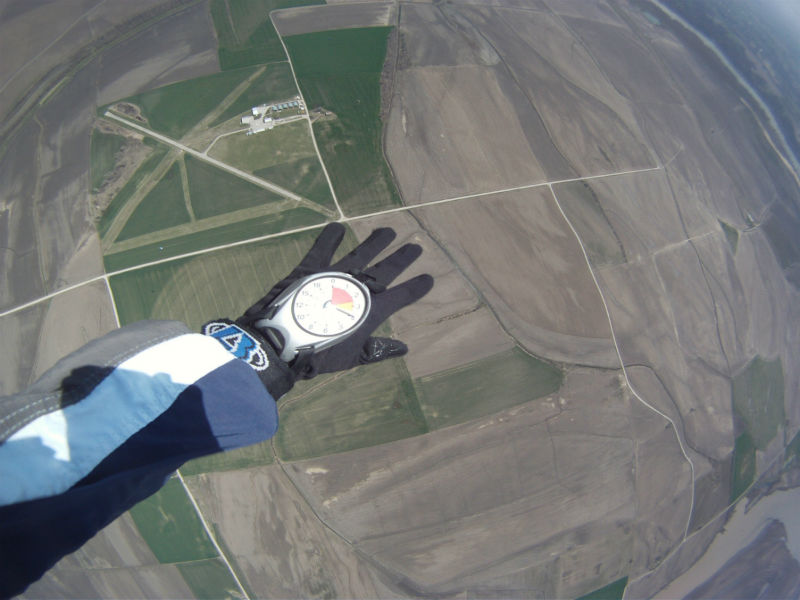This content is associated with The Open University's Sport and Fitness courses and qualifications.

Laurie Taylor:
As a teenager I had a few goes on the Grand National at Blackpool, but my most daring fairground ride was always Wallis’s Wonder Waltzer. Do you remember the Waltzer? It was those egg-shaped carriages holding up to half-a-dozen people, and the chrome rail that was lowered into your lap, and then the motion. Now an ordinary ride this just meant not much more than going up and down as you went round and round, but we knew if you gave the daring man who ran the attraction a couple of Player’s Weights, he would break the rules and slap your carriage as it descended a bump, in such a way as to make it go even faster on its axis, until you were almost lifted from your seat and carried up through the fairy lights into the dark night sky.
Of course, none of us on those Waltzer rides ever displayed any emotion. However much our body was in turmoil, however much our mind was racked with fear, it was essential – absolutely essential to stay cool, to show we were in total control of our apparently uncontrollable circumstances.
Well I thought of that paradox as I was reading a new paper in the journal Ethnography, a paper on enjoyment, risk and self-control in skydiving and in climbing. The co-author of that paper is James Hardie-Bick, who’s a Senior Lecturer in Sociology and Criminology at the University of Sussex.
That business of being in control, I mean I don’t know whether when people are climbing and whether they’re skydiving there is some sense in which they try not to show if they are concerned or stressed.
James Hardie-Bick:
Absolutely yes, that’s a fundamental part of it that you’ve got to manage your emotions, it’s almost this dialectic of fear and pleasure that you really need to manage. But the rollercoaster example is interesting because some of the skydivers that I interviewed in that research were quite critical of that similarity being made between rollercoaster rides and fairground attractions and skydiving because with skydiving it is all about maintaining control. If anything happens when – on the skydive – it’s down to you to control that situation.
Laurie Taylor:
Yes I remember because you talked about them, how they didn’t like bungee jumping, bungee jumping was really proper risk taking because it’s nothing to do with you really.
James Hardie-Bick:
Absolutely, yeah, so somebody ties something to your ankle and you jump down. Now personally I think you have to be tremendously brave to do that but they were quite critical of that absence of any skills or planning.
Laurie Taylor:
Now for this paper, the one you were doing this work on – skydiving – I mean you went parachuting yourself, just tell me a little bit about either your own fears and concerns about that or the feeling of jumping out of a plane?
James Hardie-Bick:
Well I think fears and concerns are definitely the right words to describe it. After the training, which was four days of training and you’re shown videos of what can go wrong if you climb out of the plane in the wrong way or if your lines get tangled, I learnt that your leg could get caught up in the lines, your arm could get caught up in the lines, you might be hanging underneath the plane in what’s called static line hang-up. So all these possibilities I was very much aware of, so it was quite a terrifying experience.
Laurie Taylor:
Now you were doing the research at a parachute centre, 15 months of research, speaking to men and women around the ages 20-53, different levels of experience, lots of interviews, some with women. People really much like office workers, almost could be anyone. And you wanted to challenge the way that we think about risk as a result of this research. I mean what do you think was missing, if you like, from our everyday understanding of the word risk?
James Hardie-Bick:
Well I think when I carried out this research in relation to some of the research on edge work it was really very different than I had anticipated. So some of the work on edge work was suggesting that skydivers increasingly take risks and increase the risk unnecessarily and that’s not something I found at all.
Laurie Taylor:
That phrase, just unpack it, that phrase edge work refers to the actual risk moments that are encountered during these activities?
James Hardie-Bick:
Yeah, edge work describes activities that could result in serious injury and even death. And so skydiving is an example of that and rock climbing and so forth. Alex Honnold, the free climber, free solo climber, tremendously brave and impressive videos that you can watch online, he’s climbing without ropes, if he makes one small mistake and slips off he will die. So that’s really edge work. But I was finding is that the skydivers that I interviewed were planning and practising their manoeuvres and it wasn’t about increasing risks, it was about maintaining control over difficult situations. It wasn’t about chaos.
Laurie Taylor:
Interesting because I mean, as I say, you’re talking about people – I mean they were quite close to death in a way in terms of what they were doing. But let’s actually hear one of them talking about skydiving and how they felt about it. This is one of your skydivers called Julia.:
Julia:
I want to push myself to my ability limits. Push and challenge myself. But the actual danger limits – they’re already there and I don’t need to push them any further. I know they’re there, I don’t want to increase them.
Laurie Taylor:
This is directly in line with what you’re arguing here isn’t it, that here is someone saying no they’re not going out for the risks, they’re not thinking too much about the risk, I mean they’re trying to control – it’s the controlling of the risks that’s important.
James Hardie-Bick:
Absolutely and so those who did take these unnecessary risks, which I had expected from the majority of skydivers before carrying out the research, were actually marginalised within the skydiving community, so they were referred to as cowboys, they were referred to as being stupid, arrogant. Skydivers would refuse to jump with those people because they’ll see them as taking irresponsible risks.
Laurie Taylor:
So they might not even mix with them or hang out with them at all?
James Hardie-Bick:
Yeah. Well they certainly wouldn’t want them on their plane.
Laurie Taylor:
Now you say that in the jump itself there is a kind of – I mean we should mention, by the way here, that I’m talking entirely with you about skydiving but of course your co-author…
James Hardie-Bick:
Yes, Penny – Penny Bonner…
Laurie Taylor:
She was looking at climbing and looking at the same sort of elements and factors as you were looking at here in skydiving.
James Hardie-Bick:
Absolutely and she was finding something very similar with her research on climbing as I found with skydiving.
Laurie Taylor:
Now shall we say that in the jump itself there’s a kind of merging of – you say action and awareness – I mean I don’t like this mindfulness but it’s difficult to avoid the word mindfulness here – tell me about how people talked about this merging of action and awareness and how did you perhaps experience it yourself.
James Hardie-Bick:
Well when you’re climbing out of the plane, so it wasn’t a matter of just jumping out of the plane, you have to climb out of the plane holding on to the wing strut, balancing on a small step which resembles a skateboard and then let go. And actually doing that all your actions have to be really deliberate and precise. So this merging of action and awareness – and I should mention this is from Csikszentmihalyi’s research, who’s a social psychologist – this merging of action and awareness is very much – nothing else is coming into our consciousness, we’re totally immersed in the activity. So we’re not thinking about our usual everyday worries, concerns and so forth, we’re just focusing on…
Laurie Taylor:
There’s that phrase “in the zone”, isn’t there, which tries to capture that immersion sense.
James Hardie-Bick:
Yes, yes, absolutely yes.
Laurie Taylor:
But the experience doesn’t just stay in the moment I mean it also – what’s interesting in your paper – how much it translated into life on the ground. This is one of your participants, Stuart:
Stuart:
It’s very much relief from anything else you know. A lot of people do find it sort of puts things in perspective. No matter how much trouble they’re having at work during the week, say, tedious boss and they don’t like the job and they’re not certain whether they want to continue doing this job, all these things are just not important.
Laurie Taylor:
It’s not – it seems really that Stuart here isn’t just escaping from life, it’s the way he thinks about life, it is part of his broader identity.
James Hardie-Bick:
Yes, in that interview he was saying how it’s prioritised certain aspects of his life in terms of what’s really important to him. And the merging of action and awareness, when you’re completely focused on that task at hand and you’re not letting the usual worries and concerns come in to consciousness. But after when usual levels of self-consciousness returns then you’re reflecting on your achievements or your disappointments and so forth and I think it’s that process of being completely immersed in what you’re doing, silencing those everyday conversations, that internal self-dialogues, that moment they found – participants found very rewarding.
Laurie Taylor:
So really I go up to these participants who are taking part in what seemed to me very, very daring – and I start talking to them about – gosh the risk and you must get terribly frightened – that’s not really the terms in which they talk to each other about what they’re doing.
James Hardie-Bick:
In fact with many of the skydivers it was a reverse. So people who had stereotypical assumptions about skydivers going to the drop zone to carry out parachute jumps and would be talking about how crazy it is and how risky it is and so forth and the skydivers at the centre would find this quite amusing because that’s not what it’s about at all. So that was much a stereotypical assumption outside the skydiving community.
Laurie Taylor:
It is a very interesting paper, congratulations to you and to your co-author.
This discussion was originally broadcast on Thinking Allowed on BBC Radio 4 on 15th March 2017. You can listen to the full programme online.

Rate and Review
Rate this article
Review this article
Log into OpenLearn to leave reviews and join in the conversation.
Article reviews